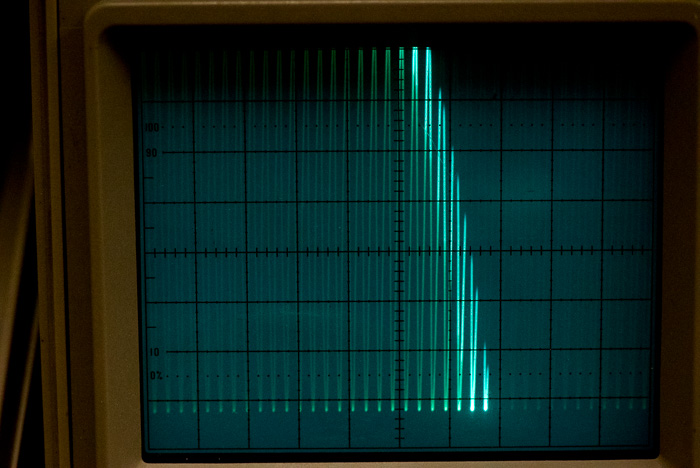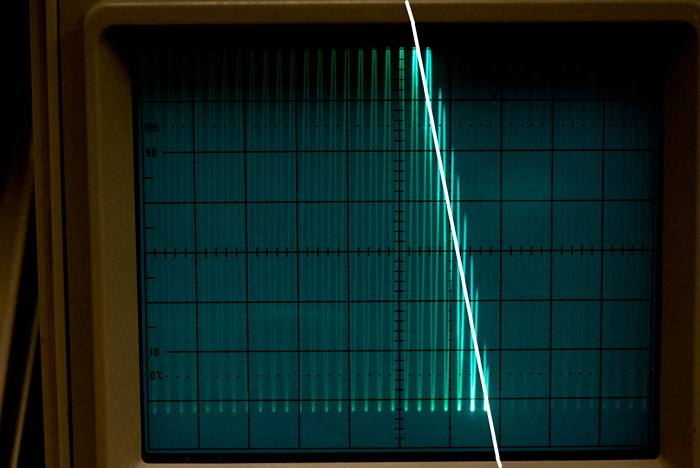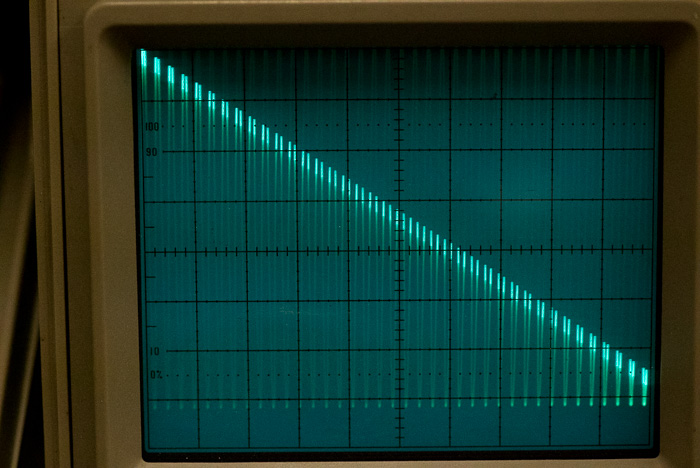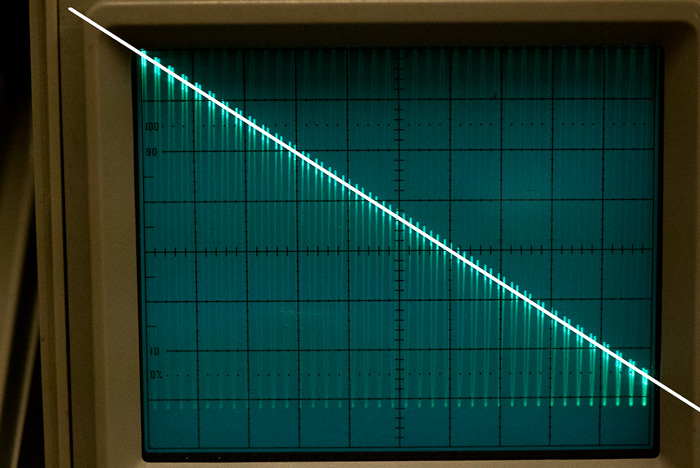The a7S has a silent shutter mode. When running silent, the mechanical shutter is on vacation, lying back and catching Z’s while the sensor does all the work. The mechanical shutter is a rabbit, completing an exposure in 1/250 second (for shutter speeds faster than that, a slit moves across the sensor, but it takes the slit a little under those 4 milliseconds to make its journey. The fully electronic shutter is a tortoise, taking longer to do its job.
How much longer? I thought I’d find out.
I set up an analog oscilloscope with an input from a function generator. If you’re going to try this at home, don’t try it with a digital scope; it won’t work. I set the time base to 2 msec/division, and the amplitude of the generator to just short of maximum excursion for the scope’s vertical sensitivity. I mounted a 105mm f/2.8 Micro-Nikkor on the a7S with a Metabones adapter that I’d modified by removing the foot. I but the RRS plate on the camera and clipped it into a RRS tripod. I set the camera for electronic first curtain shutter, with silent shutter off. I set the camera to manual exposure, and the shutter speed to 1/1000 second – that’s one msec. I stopped down a bit and cranked up the ISO to 16000 to get a good exposure.
I took a picture:
Because of the persistence of the scope’s phosphors, there is quite a bit of residual glow. Try to ignore that and only consider the bright part of the trace. If you do that, you can see that it’s about half a division wide. One division is 2 msec, and we set the shutter to 1 msec, and half of two is one. Isn’t it nice how that worked out? Now notice that the bright part of the image is not vertically oriented, as it would be if every part of the image was exposed in the same 1/1000 second. It’s diagonal. Since scope traces from left to right, the fact that the top of the diagonal is left of the bottom means that the shutter exposed the top of the image before it exposed the bottom. Since the image is upside down on the sensor, that means that the a7S’s mechanical shutter must move from the bottom of the camera to the top.
We can also look at the picture and tell how long the shutter took to go from the bottom of the camera to the top. If we run a line parallel to the diagonal and extend it to the top and bottom of the image like so:
We can see that it takes the shutter about two divisions to go from the bottom of the camera to the top. Two divisions is 4 msec, which is what the synch speed of the a7S is. That’s nice.
Now, let’s leave everything the same except that the camera is in silent shutter mode, and take another picture. This is what we get:
Gee, the silent shutter takes longer to get the job done. How much longer?
Let’s draw our line again:
Oops, it’s off the screen on the right and the left. We’ll just have to guess how many divisions it would take to go from the top to the bottom. I’m guessing two more on the right, and 2.5 more on the left. The line itself is about 2.5 divisions greater in horizontal extent than the ten divisions on the screen. So, 10 divisions on the screen, plus 2.5 plus 4.5, is about 17 divisions. That’s 34 milliseconds. So the Sony a7S silent shutter takes about 34 milliseconds, or roughly 1/30 of a second, to make a complete exposure.




Harold says
Thanks for the great testing here on the A7S.
What does this mean for the electronic shutter ? Does it mean that shooting at 1/30 or less won’t work ?
How about faster shutter speeds ? Does this mean that 1/200 would be free from rolling shutter effects ?
Im confused as to the practical effects on stills photography ?
Rgds
Jim says
It doesn’t mean that 1/200 would not have rolling shutter effects. Quite the contrary. Exposures of shorter than, say, 1/8 (two stops slower than the shutter transit time) would have them, and exposures shorter than 1/30 could exhibit classical rolling shutter artifacts like elliptical wheels. You’ll be fine as long as your subject isn’t moving rapidly, but you will see some strage effects if it is. Try photographing an electric fan set to low rpm and see for yourself.
Mechanical focal plane shutters have the same issues, but, since they take 4 to 8 milliseconds to traverse the frame rather than 33 or 34, you don’t see the artifacts until the subject is moving really fast.
Rolf says
No it does not mean that you can not shoot anything faster than 1/30. In fact you can usually shoot faster shutter speeds with electronic shutters, like 1/16000. I don’t know about the A7S in particular, this is just a general statement.
How come? Most people think that when you shoot, say 1/2000, a fast speed that is, with a mechanical shutter, the first curtain opens totally, the image is exposed for 1/2000 of a second, then the 2nd curtain ends the exposure. That’s not exactly what happens. When you’re shooting at high speeds, the shutter is essentially a slit between the first and 2nd curtain, traveling up (or down) the sensor. Look for slow motion, very high fps shutter videos on youtube, you’ll see what I mean.
Electronic shutters are the same. It takes 1/30 for the A7S to expose the whole frame, but at the end of the exposure, every pixel of the frame may have received the equivalent of as little as, say, 1/500 exposure.
What it means is that if the subject moves within 1/30, then you will have rolling shutter (jello effect) artifact. Whenever you might have motion blur at 1/30, you might also have jello effect.
1/30 is pretty slow and will be a problem on most but the widest lenses.
So geez that’s a slow speed.
But then when you’re usually using the silent shutter, you’d be close to your subject (otherwise you’d be too far from them to hear the shutter), and probably shooting with a relatively wide angle. It’s still a very nice option to have.
Now if they please would do something nice and grant it to other cameras.
Marcel says
Great test, thank for this! Exactly what I was looking for. So it’s faster than gh4’s 1/10. Cheers.
Rolf says
That’s pretty impressive considering that the bigger sensors take longer to read.
1/10 for a sensor as small as the GH4 is nothing to be proud of.
HSSwan says
Thank you. You’ve answered my question graphically.
RandomGuy says
Very interesting findings. Yet, something is bugging me about the results:
The a7S can record video at 60p. Allegedly, it does full sensor read-out, grabbing 4K from the sensor and then downsampling it to Full HD internally. A 4K frame only has roughly 8 MP as opposed to the 12 MP of the whole frame. So, according to your measurement, the a7S takes at least 8 MP / 12 MP * 34ms = 23ms to scan a video frame. That would be enough for 50p, but a 60p frame lasts for only 17ms.
Jim says
I can just tell you what happens in still mode. It’s entirely possible, even likely, given the way the camera changes timing and bit depth with various still modes, that it does something different in video mode, where it doesn’t provide the bit depth that it does in raw.
Jim
RandomGuy says
Sensor readout speed is a native property of the sensor and cannot be changed easily.
Short version: It looks like the a7S only does full sensor readout up to 30p. From 50p on it does line skipping unless you switch to crop mode. Then it only has to read roughly 5 MP, resulting in 5 MP / 12 MP * 34ms = 14ms. This is still just below the maximum of 16ms.
Your findings are the explanation to all of this: The rolling shutter takes 34ms to scan the whole frame, and at each video mode, the camera makes the most out of it, skipping lines only when it could not keep up otherwise.
Christopher Perez says
You say “…I set up an analog oscilloscope with an input from a function generator. If you’re going to try this at home, don’t try it with a digital scope; it won’t work…”
I know this is long past, but I’m wondering a couple things.
The function generator is doing what, exactly in your test setup?
Where are your probe points and how are you getting at them? I’m curious because I’m assuming you are measuring something that gives voltage vs time, right?
Lastly, why, exactly would a digital ‘scope not work? Is it something about your test setup?
JimK says
It’s filling the entire vertical extent of the scope with a signal that progresses at a constant rate horizontally across the face of the oscilloscope.
The vertical axis hot input for the scope is connected to the output of the function generator. The ground of the scope input is connected to the ground of the function generator.
On a digital scope, the horizontal sweep of the display is not necessarily that of the timebase selected. The display is not updated in real time as with an analog scope.
Keep in mind that the scope is not used to actually measure anything. It merely provides a time-varying display to allow the dynamics of the shutter to be made visible.
Christopher Perez says
Ah. Interesting. I have to admit that your oscilloscope probing points are not what I was expecting. I was thinking perhaps you’d found the start/stop shutter points in the camera itself. Makes me wonder where the camera is in your test setup and how you’re getting at the signals.
As for digital ‘scope displays not being realtime, I think Tektronix back in the ’90’s had solved that in their first DPO series. But I’ll grant that there’s a lot about your test setup that I don’t know about nor understand.
Steady on and thanks for having taken the time to reply.